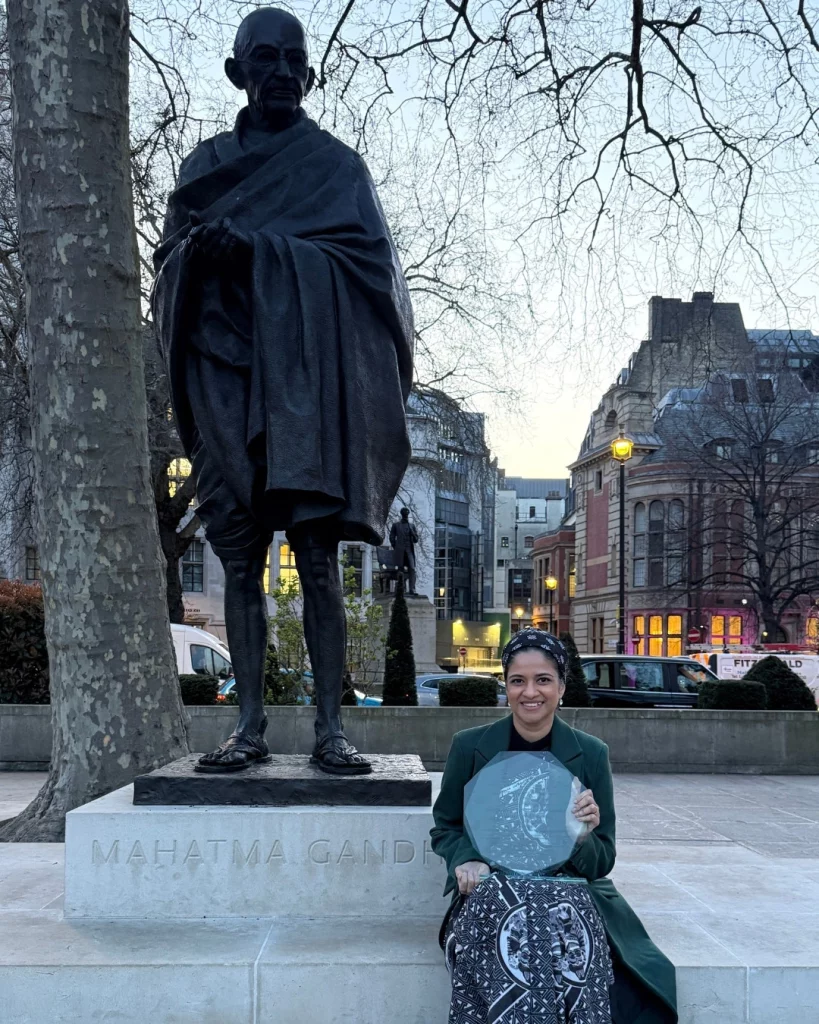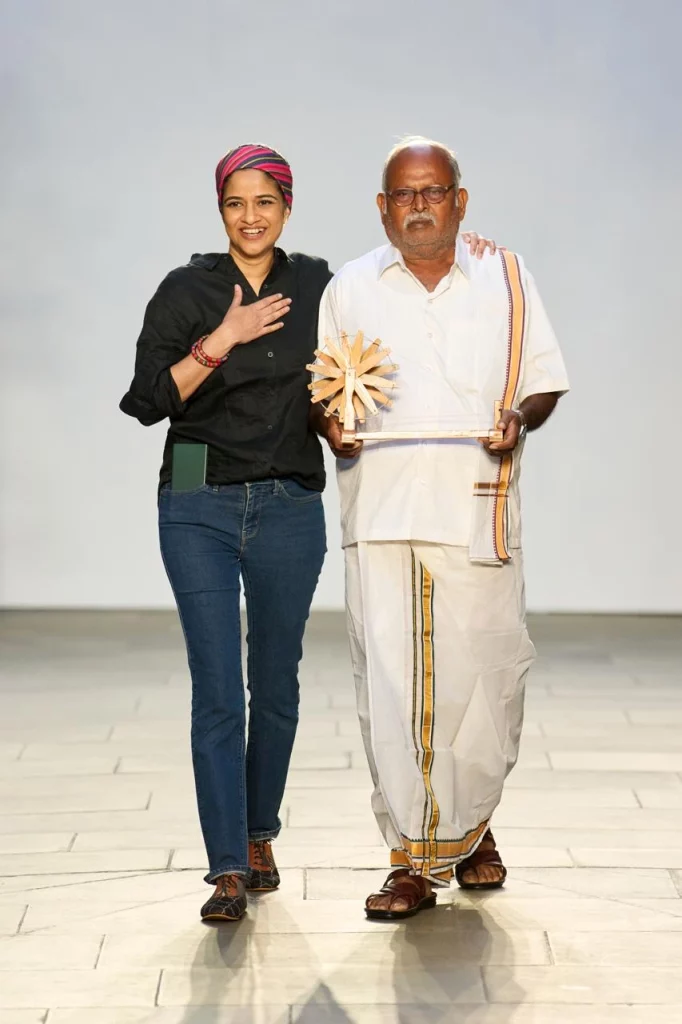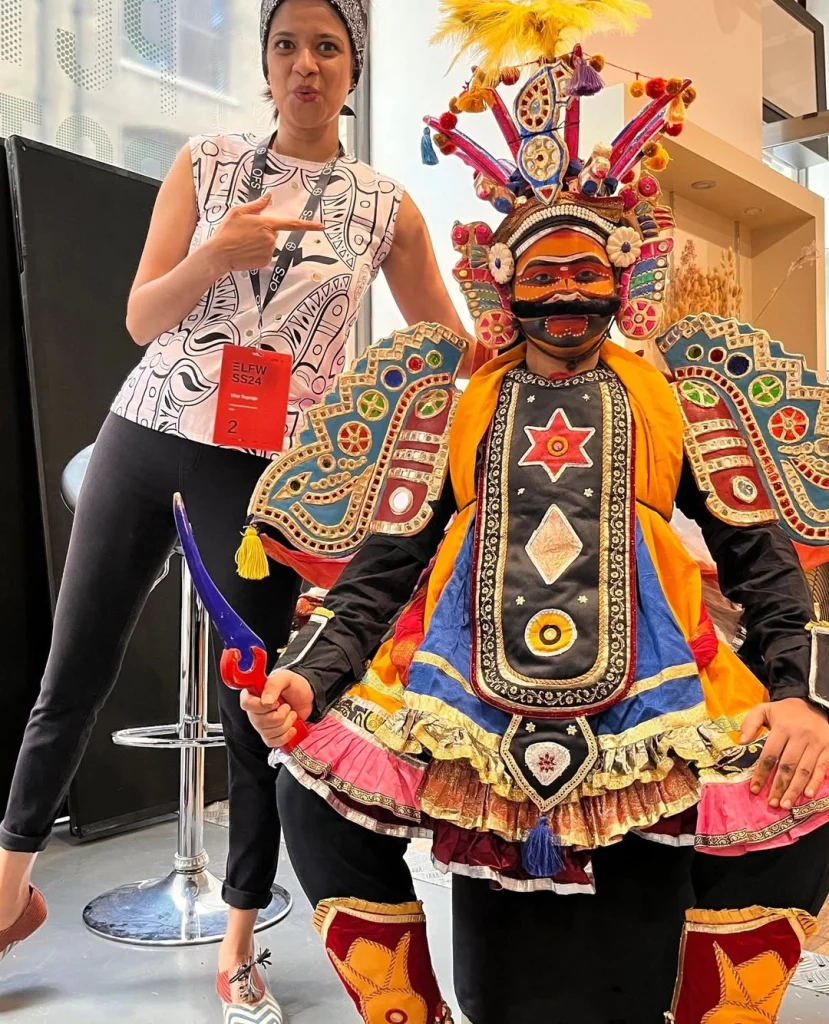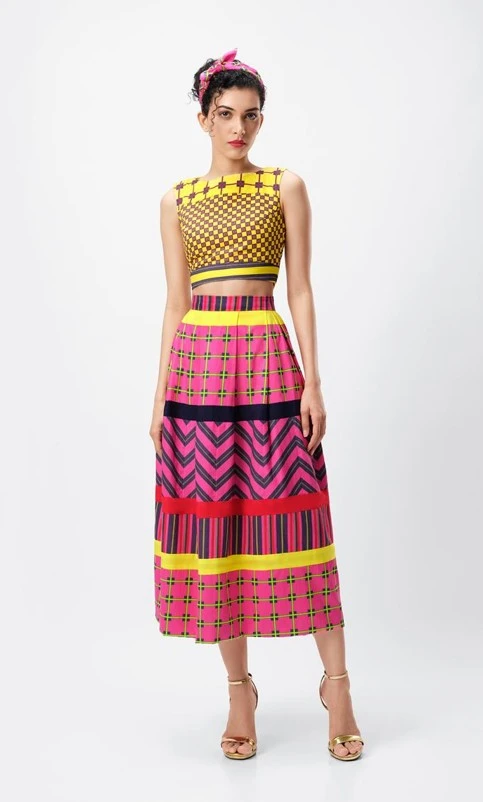(November 8, 2025) Enrolling in a Bachelor’s program in Fashion Design at the age of 32 wasn’t easy for Vino Supraja. Her classmates were fresh out of high school, and she was juggling motherhood and a full household while living in Shanghai. But passion pushed her forward. Her graduation collection won two international awards and was selected for Shanghai Fashion Week 2014. Eventually, she went on to showcase her work as a designer at Brooklyn Fashion Week, 2016, New York Fashion Week, 2017, and twice at London Fashion Week, first in 2023 and then 2025.
“That (Shanghai) debut on the runway was my first realization that fashion could be a canvas for storytelling. It marked the true beginning of my design journey,” smiles the fashion designer in a chat with Global Indian.
Born in Vellore, and raised in Vandavasi, Tamil Nadu, Supraja’s life has been a journey of reinvention from architecture and media to ethical fashion. A physician’s daughter and former radio jockey, her story beautifully ties together art, sustainability, and social consciousness. This fusion makes her one of the most compelling voices in sustainable fashion movement.

Vino Supraja
London Fashion Week
Her recent showcase, ‘WEAVE: A Bhavani Tribute,’ marked Supraja’s second appearance at London Fashion Week. It was produced by Oxford Fashion Studio, who were celebrating their 10th anniversary. Having worked with her before, they approached the fashion designer asking if she had something special to present for this milestone.
Around that time, Supraja was already collaborating with the Bhavani Jamakkalam weavers on reimagining the heritage textile into luxury handbags— which they had launched earlier in January 2025. “It felt like the perfect moment to take this craft to a global audience. From the beginning, I knew this couldn’t just be another fashion showcase.”
The textile and the weaver
The Bhavani Jamakkalam is a centuries-old handwoven textile that has been part of Tamil Nadu’s heritage for generations. The weavers are the true custodians of this legacy. She decided to make the collection a tribute to the weavers of Bhavani, and to take one of them to the London runway to share that spotlight. “That’s how Sakthivel Periyasamy, a senior weaver who has spent over five decades weaving Bhavani Jamakkalams, became the face and soul of our collection.” For his appearance on the runway, Supraja dressed Sakthivel in a traditional white vesti with zari border, a crisp white shirt, and an angavastram — an image of grace, simplicity, and pride.
For the audience at London Fashion Week, this was the first time they saw a weaver walk the runway as a celebrated guest of honour. “Many in the audience had tears in their eyes; it was a moment of history, a collective realisation that fashion is not just about glamour, rather about the human hands that make it possible.”

Vino Supraja with weaver Sakthivel Periyasamy at the London Fashion Week
Every creative element of the show was built around this imagery — the weaver taking the bow alongside the designer. “The models carried the Jamakkalam handbags, and the garments drew inspiration from the textile’s signature stripes and vibrant colours, creating a dialogue between tradition and modernity.” Supraja and team also commissioned an original score blending ancient Tamil folk instruments like Tharai, Kombu, Pambai, Parai, Jimla Melam, and Periya Melam with an English rap inspired by Subramania Bharathiyar’s poetry, composed by Paul Jacob and performed by BlaaZe, with vocals by Chinna Ponnu and Antony Dasan.
A trip to Bhavani
It all began with a trip to Bhavani, a small town in the Erode district ofTamil Nadu, known for its Bhavani Jamakkalam, a vibrant handwoven rug where the weavers spoke of dwindling demand and uncertainty about the future. “I felt a deep urge to help them reimagine this beautiful textile beyond its traditional purpose. That was how our collaboration began,” she recalls.
Together with the weavers, she experimented with the Jamakkalam fabric to bring it into modern relevance, developing prototypes that eventually became a line of luxury handbags crafted from the original handwoven textiles.
Storytelling roots
For nearly five years, Supraja worked as a radio jockey, producer, and television host, enjoying every bit of storytelling and audience connection that came with the role. But when her husband’s work took them to Shanghai, her career in media came to a pause. Not one to sit idle, she started looking for courses in screenwriting and television production. “Every website I opened was in Mandarin. Finally, two websites appeared in English: one was a business school, the other a fashion school.” Fashion caught her attention instantly. “With my background in architecture and media, both creative, visual disciplines, fashion felt like a natural extension.”

From Shanghai to the US
From Shanghai, the family moved to Detroit. It was here that she stitched her first independent collection on a home sewing machine. “My husband photographed it, and I sent it to anyone who might listen, long before the influencer culture began.” One producer took notice, and that small start led to her work being shown at Brooklyn Fashion Week 2016 and later at New York Fashion Week 2017.
Move to Dubai and transformation
The family then shifted to Dubai, where she entered a different kind of fashion landscape which was dominated by luxury giants. Instead of rushing into it, she decided to pause and study Fashion Marketing, to understand how to communicate sustainability and purpose within a luxury space. During that course, she watched the documentary The True Cost on Netflix, which revealed the harsh realities of fashion’s impact on people and the planet.
“Having grown up watching my father serve his community selflessly, the disconnect between glamour and ground reality shook me deeply,” says Supraja, of her moment of transformation. In 2019, she consciously turned her brand into a sustainable and ethical fashion label, combining her design instincts with a responsibility towards people and the planet.
Family and early life
Her father, Dr. Adikesavalu, was a well-respected physician who devoted more than 50 years of his life to serving the villagers around Vandavasi, Tamil Nadu. Her mother, Vimala Adikesavalu, ran a small school in the town, where Vino Supraja studied until her 10th grade. Thereafter, she continued her higher secondary education at Government Boys Higher Secondary School, which was the only English-medium option available then.
After completing her degree in Architecture in Chennai, Supraja pursued a short course in animation. She married her classmate and best friend from architecture, Dr. Deepak Renganathan, who holds a doctorate in Artificial Intelligence and currently serves as Vice President at a leading real-estate company. Their son, Hriday Deepak, is pursuing medicine at the Royal College of Surgeons in Ireland.

Design language and inspirations
Supraja’s home didn’t have a television or cable connection until after she completed school, so her world revolved around the temple behind her house. “The festivals, bhajans, and Therukoothu performances held there became my first theatre, my first stage, and the heart of my early creative awakening.”
Those evenings filled with devotional songs and storytelling shaped her sense of rhythm, costume, colour, and culture—seeds that would later grow into her design language. As a child, she was curious and expressive, always singing, dancing, and performing, though she wasn’t formally trained. Academically, she was a top student and loved learning. Sports, however, was not her forte. “My physical outlet came through dance, chores, and long walks around our village,” says the fashion designer, who seeks inspiration for her work by going back in memory to those early days—the temple sounds, the weavers in nearby villages, the simplicity of rural artistry.
Collaboration and sustainability
Supraja’s collaboration with artisan and weaving communities is at the heart of everything she creates. Her first and most enduring association began with the Chennimalai weavers of Tamil Nadu. Since the moment she made a conscious shift toward sustainable fashion, the fashion designer has partnered with Five P Ventures, a GOTS-certified weaving studio that represents the best of ethical manufacturing.
“What drew me to them was not only their exquisite organic cotton fabrics, but their complete ecosystem of integrity—a green-certified facility, community canteen for workers, transparent wages, and genuine welfare initiatives for every artisan involved.” At Supraja’s studio, sustainability starts from the yarn. “We work with GOTS-certified organic cotton woven by Chennimalai weavers, and use AZO-free dyes that protect both the environment and the artisans who handle them,” she explains.
She maintains mindful production processes — small-scale, transparent, and fair. “Through our 30 Wears Initiative, we encourage customers to wear each garment at least 30 times before recycling it for a discount, closing the loop between design and responsibility.” But beyond materials, ethical fashion is about people. “True sustainability cannot exist without social responsibility, and to me, that’s where the real beauty lies,” says Supraja.
Earthy and soulful colours
As a designer, she is deeply drawn to colours that tell stories. Her colour palette often sits somewhere between the two — earthy and soulful, yet bold and expressive. “I love the organic tones that nature offers: the soft beige of sand, the muted greens of foliage, the indigo of the twilight sky, and the fiery reds that speak of celebration,” says Supraja. Every hue carries emotion. “For instance, the marigold yellow often reminds me of temple festivals in my hometown, while deep indigo connects me to the calm of handmade dyeing traditions.”

A design creation by Vino Supraja
Fashion and India
Supraja says India has always been a land of incredible artistry and craftsmanship. Yet, the world often perceives the country as a land of mass production or cheap labour. “I want that perception to change,” emphasises the fashion designer. “We come from a culture where work is worship. Every motif, weave, and stitch carry centuries of heritage and devotion. Our weavers, dyers, embroiderers, and artisans are the real custodians of Indian fashion.”
Inspiration
Travel and reading are Supraja’s greatest sources of inspiration. Every journey she undertakes, whether to a small weaving village in Tamil Nadu or a museum in Europe, opens up new perspectives. “It allows me to observe textures, colours, and human emotions that later find their way into my designs,” says Vino Supraja, an avid reader.
ALSO READ: 25 years of Sabyasachi: The designer who brought Indian heritage to the world



